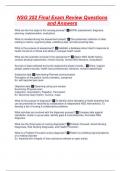NSG 252 Final Exam Review Questions
and Answers
What are the five steps of the nursing process? ✅ADPIE (assessment, diagnosis,
planning, implementation, evaluation)
What is included during the assessment phase? ✅The systematic collection of data
relating to clients, organizing data, validating data, and documenting data
What is the purpose of assessment? ✅Establish a database about client's response to
health concerns or illness and ability to manage health needs
What are the activities involved in the assessment? ✅Obtain NSG health history,
conduct physical assessment, review records, review NSG literature, consultation
Sources of data collected during the assessment phase include... ✅Client, support
people, patient records, health care professionals, literature, nurse's experienced
Subjective data ✅Interviewing-Planned communication
Perception of the patient, family members, caregivers
Ex: self reported pain level
Objective data ✅Observing using your senses
Examining-Physical exam
Inspection, Auscultation, Palpation, Percussion
Ex: Abnormal heart rhythm, murmur, mass
What is the purpose of diagnosis? ✅To identify client strengths & health problems that
can be prevented or resolved by collaborative & independent NSG interventions. To
develop a list of nursing & collaborative problems.
What activities are involved with the diagnosis process? ✅Compare data against
standards, cluster or group data, identify gaps & inconsistencies, formulate NSG
diagnosis.
What are the three types of nursing diagnoses? ✅Problem-Focused, Actual Nursing
Diagnoses, Risk Nursing Diagnoses, and Health Promotion
What is a Problem-Focused nursing diagnosis? ✅Patient is exhibiting signs/symptoms
of a medical disorder
Ex. Impaired skin integrity (if has cutaneous redness or open areas)
, What is a Risk Nursing Diagnosis? ✅Patient has risk factors present, but NO signs or
symptoms of medical disorder
Ex. Risk for impaired skin integrity (very thin, bedrest, immobile, poor nutritional status)
What is a Health promotion nursing diagnosis? ✅Based on patients' identified
strengths (motivations)
Ex. Readiness for enhanced nutrition, Readiness to learn
What are the three components of a NANDA Nursing Diagnosis? ✅Diagnosis,
Etiology, and Defining characteristics
Diagnosis... ✅The problem & definition; describe client's health problem
Etiology... ✅Identifies one or more probable causes of health problem
Defining characteristics... ✅Cluster of signs & symptoms that indicate presence of a
particular diagnostic level
What is the format of a Nursing Diagnosis? ✅Diagnosis (based on assessment data -
Problem Focused Diagnosis, Risk Diagnosis, Health Promotion Diagnosis)...related to
(etiology - what is causing the problem)...as evidenced by (defining characteristics)...
Maslow's Hierarchy of Needs ✅Physiological (breathing, water, sleep), Safety (security
of body, employment, resources, health), Love/Belonging (friendship, family), Esteem
(self-esteem, confidence, achievement), Self- actualization (morality, creativity, problem
solving)
Planning is a two part process composed of... ✅Identifying goals and desired
outcomes based on the nursing diagnoses
Selecting appropriate nursing interventions
What are SMART goals? ✅Specific, Measurable, Achievable, Realistic and Timely
What is Implementation? ✅Putting the plan of care into action-utilizing nursing
interventions
What is Direct Care Intervention Implementation? ✅Treatments performed through
interactions with patients
Medication administration, insertion of an IV, counseling, teaching, ADL's, life saving
measures, controlling adverse reactions, preventive measures
What is Indirect Care Intervention Implementation? ✅Treatments performed away from
the patient on behalf of the patient
Safety, infection control, documentation, collaboration, delegating




